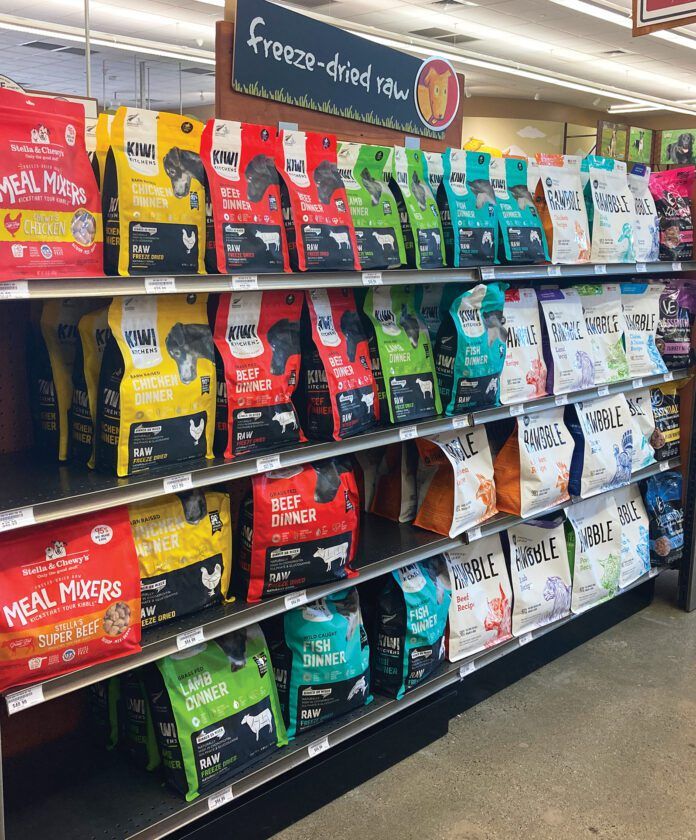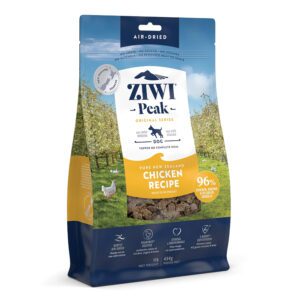
This category of dog foods is an outgrowth of the “raw diets for dogs” revolution that was sparked in 1993 with the publication of Give Your Dog A Bone, written by Australian veterinarian, Dr. Ian Billinghurst. In that and several follow-up books, Dr. Billinghurst made a case for the benefits of feeding dogs a diet that was similar to what their ancestral predecessors ate, namely raw meats, organs, and bones, improved by the addition of minor amounts of other foods (vegetables, fruits, grains).
While Dr. Billinghurst’s original goal was to empower dog owners to prepare their dogs’ food themselves, the immediate popularity of this type of diet created a market for commercial raw pet food, usually sold in frozen form. But these diets required constant freezing and reliable, fast, expensive shipping. When some manufacturers began freeze-drying their raw, frozen products in order to create shelf-stable products that were light and inexpensive to ship, a whole new industry was born.
Today, this category of food hangs loosely together by one main attribute: a high inclusion of raw meat. But the methods the pet food companies use to manufacture these foods vary quite a bit – with freeze-drying, air-drying, or dehydration processes – and the offerings grow more eclectic every year.
As disparate as they are, the products in this category share these attributes:
- A high meat inclusion. Many of the companies claim that their products consist of 80% or more of meat, organs, and (ground) bone. Some claim to contain as much as 95%! The inclusion of organ meats (such as heart, liver, kidneys, lungs, beef tripe, and chicken gizzards) is common, as is the use of fresh ground bone. The resulting diets are highly digestible.
- Low or zero carb content. Most (not all) of the products in this category have a very low carbohydrate inclusion. The outliers are products from Earth Animal and some of The Honest Kitchen’s foods. (Remember, dogs don’t require carbs; they can live on fat and protein alone, as long as they get the vitamins and minerals they need.)
- High protein and fat content. Keep in mind that if you don’t include carbs in a diet, only protein and fat remain. Some of these products may contain more fat than is healthy for dogs who are overweight and/or sedentary, or who are intolerant of fat (such as dogs who are prone to pancreatitis).
- These diets tend to be highly palatable to most dogs. Whether due to the high meat inclusion, the high fat content, the high-quality ingredients, the concentration of flavor in freeze-dried food ingredients, or the minimal processing, these foods are almost universally accepted by dogs.
Subscribers Only: Whole Dog Journal’s 2024 Approved Freeze Dried/Dehydrated Foods
How is Freeze-Dried Dog Food Made?
Freeze-dryers expose foods to low temperatures, freezing them relatively quickly. When the pressure inside the freeze-drying chamber is reduced, the trays that the food sits on are heated, causing the frozen water in the foods to transform into a gas (water vapor). Vacuum pumps pull the vapor out of the chamber until the desired moisture level is reached. Proper freeze-drying doesn’t affect the appearance or taste of foods much.
 The makers of the dehydrated foods universally describe their products as “gently air dried,” making the process sound very benign. However, these foods are dried with temperatures of 140ºF to 180ºF, which changes the cellular structure (and thus the aroma, taste, and appearance) of meats, fruits, and vegetables. Note that these temperatures don’t qualify the food as “cooked.”
The makers of the dehydrated foods universally describe their products as “gently air dried,” making the process sound very benign. However, these foods are dried with temperatures of 140ºF to 180ºF, which changes the cellular structure (and thus the aroma, taste, and appearance) of meats, fruits, and vegetables. Note that these temperatures don’t qualify the food as “cooked.”
The freeze-drying process sounds extreme, but the process leaves most foods less damaged than dehydration, which toughens meats and other ingredients. To counter this, the moisture in air-dried diets is not as drastically low as it is in freeze-dried foods. Most freeze-dried dog diets contain as little as 5% moisture – about half the moisture content of kibble – but some of the air-dried products contain more moisture than most kibble. Ziwi Peak’s products contain a maximum moisture content of 14%, and Earth Animal’s Wisdom foods indicate they contain 18% moisture (maximum); most kibble diets contain 9% to 10% moisture.
Either process preserves the food with less damage to natural enzymes and vitamins than baking or extrusion. However, this means that the meats and other ingredients are, by definition, raw.
Subscribers Only: Whole Dog Journal’s 2024 Approved Freeze Dried/Dehydrated Foods
Raw Foods and Pasteurization
Federal law prohibits the presence of any pathogenic bacteria in pet foods. This presents raw-food manufacturers with quite a challenge, since, as you might be aware, raw meats – even the cuts sold in your favorite grocery stores – are frequently contaminated with pathogens, including Salmonella, Campylobacter, Listeria, and e. Coli. Each of these species of bacteria is capable of causing serious illness in humans and dogs (although, of the four, Salmonella rarely causes illness in dogs).
The thing is, it’s presumed that raw meats will be cooked before they are consumed by humans, and proper cooking renders any bacteria present harmless. Raw pet food makers have a few different processes available that will kill any pathogens present without cooking the food, and most are using at least one of them.
The most popular “kill step” in use for raw meat diets today is known as high pressure processing (also known as high-pressure pasteurization, and in either case abbreviated as HPP). HPP is also used to pasteurize many raw human foods, including many packaged lunch meats, guacamole dips and salsas, and fruit and vegetable juices.
But some of the makers of the meaty canine diets we’re discussing are such strong proponents of raw food diets for dogs that they have resisted, and continue to resist, using any sort of bacterial kill step. Instead, these companies depend on incoming ingredient testing, good manufacturing processes, and the use of “test-and-hold” programs, whereby finished products are tested for pathogens and not released for sale until results indicate the products are uncontaminated.
A test-and-hold program may succeed in detecting products that contain pathogens, enabling the company to dispose of those products and preventing them from being shipped out. But testing can’t ensure the absolute absence of bacteria in the product; only a verified kill step can guarantee a lack of pathogens in diets that contain raw meat.
Most food-industry experts feel strongly that HPP is a very safe technology; we do, too. Our personal preference is to buy products that have been rendered free of pathogenic bacteria by HPP. But we respect the right of owners to feed raw foods that have not undergone a kill step – as long as they are informed about the risks to which they are subjecting themselves and their dogs.
Interestingly, some of the makers of these products are very up-front about their use of HPP or another bacterial kill step, and others are equally forthright about their choice to forgo the use of a kill step. Still others do not disclose on their product labels or websites whether or not they use a kill step. In each case where we could determine the tack taken regarding pathogenic bacteria by each of the companies on our “Approved Freeze-Dried Dog Foods” list, we have included this information.
Approved Freeze-Dried and Dehydrated Dog Foods
On the table linked below, we included companies that are making diets that meet our selection criteria, which can be abbreviated thusly: No unnamed meats or fats; only whole, lightly processed, “real food” ingredients; and no artificial colors, flavors, or preservatives.
The table also includes the range of protein and fat levels found in the products offered by each manufacturer. We’ll repeat this, because it’s important: Virtually all of the products in this category are high in protein and fat. It might be impossible to find an appropriate diet for a dog who cannot tolerate high fat levels in this category.
We’ve listed prices for the largest size of the products that are available; the larger sizes are generally the most economical – if that can be said at all of this category. These foods are expensive! Because of this, we suspect that few people feed them as a sole diet unless they have just one or two small dogs. With three large dogs at home, we use products in this category intermittently, mostly as training treats or as a highly nutritious food “topper” that tempts the appetite of dogs or foster puppies who are feeling under the weather.
Subscribers Only: Whole Dog Journal’s 2024 Approved Freeze Dried/Dehydrated Foods






Is anyone having trouble with their Whole Dog Journal account? I received an email that someone (not me) had changed my password. So, I reset my password and was able to login. But now I cannot delete my payment information from my account. Has the Whole Dog Journal system been compromised?
Vital Essentials website shows that BOTH the zturkey MINI NIBS AND the Turkey mini patties have the EXACTLY the SAME ingredients AND the same protein at 55% and Fat 17%.
You have the Turkey mini Pattie’s at 44% protein and 30% fat.
So is Vital Essentials WRONG about that or Whole Dog Journal because that’s a BIG difference???????
If there is a discrepancy between our data and the manufacturer, I would of course trust that the manufacturer would have the most current information. I don’t know if the information changed since our database was populated many months ago, or whether a data entry error was made. If we made an error, we apologize. Vital Essentials currently shows 53% protein and 17% fat.
Do you have any information on Badlands air dried Superfood Chicken or Beef?
Yes it would be great to get any feedback on this food. thanks